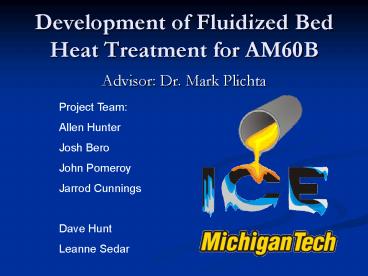Development of Fluidized Bed Heat Treatment for AM60B - PowerPoint PPT Presentation
1 / 27
Title:
Development of Fluidized Bed Heat Treatment for AM60B
Description:
Develop a fluidized bed heat treatment process for squeeze cast AM60B magnesium ... Samples examined for incipient melting. Heat Treatment Results ... – PowerPoint PPT presentation
Number of Views:164
Avg rating:3.0/5.0
Title: Development of Fluidized Bed Heat Treatment for AM60B
1
Development of Fluidized Bed Heat Treatment for
AM60B
- Advisor Dr. Mark Plichta
Project Team Allen Hunter Josh Bero John
Pomeroy Jarrod Cunnings Dave Hunt Leanne Sedar
2
Industry Support
- Bruce Cox, DaimlerChrysler
- Eric McCarty, DaimlerChrysler
- Rich Jacques, SPX Contech
3
Outline
- Project Focus
- Objectives
- Background
- Experimental Procedure
- Results
- Conclusions
4
Problem Statement
- Develop a fluidized bed heat treatment process
for squeeze cast AM60B magnesium automotive
components which improves mechanical properties
to meet safety critical standards
5
Objectives
- Use a fluidized bed heat treatment process to
- Increase mechanical properties
- Tensile strength
- Ductility
- Hardness
- Decrease heat treatment times compared to
conventional forced air furnaces
6
Magnesium vs. Aluminum
- Disadvantages of Mg
- Inferior mechanical properties
- Greater material cost
- Low operating temperature (lt190C)
- Advantages of Mg
- Lighter material
- Better damping
- Lower melting point
- Allows for longer die life
7
High Integrity Magnesium Automotive Components
(HIMAC)
- Improve fuel economy through weight reduction of
parts - Use of magnesium instead of aluminum
- Improve mechanical properties of magnesium
- Call for minimum 7 elongation for safety
critical parts - Most as-cast magnesium alloys dont meet this
requirement
8
Casting Mg
- Die Casting
- Majority of automotive magnesium castings
- Unable to be heat treated due to blistering
- Squeeze Casting
- Slower solidification
- Lower turbulence
- Minimizes porosity
- Able to be heat treated
9
Squeeze Casting
Metal fills mold over 2-3 seconds and solidifies
from the top down
Metal Squeezed into mold cavity
Top Die
Bottom Die
Molten Magnesium
10
What comprises precipitation hardening heat
treatment?
- Solution treatment
- As-cast structures contain multiple phases that
are detrimental to mechanical properties - Solution treatment creates a single phase solid
solution - Age Hardening
- Causes fine uniformly-dispersed second phase to
precipitate - This results in increased mechanical properties
11
AM60B AlloyASTM B94-94
12
Al Mg Phase Diagram
S
A
13
Fluidized Bed Heat Treatment
- What is it?
- Heated air forced through granular media
- Media is fluidized by the air
- Samples are immersed inside bed
Air Line
Samples in wire basket placed in bed
Carbon Dioxide Line
14
Fluidized Bed
15
Fluidized Bed
- Why use it?
- Significant reduction of time with Al alloys
- Similar results anticipated for Mg alloys
- Used for Solutionizing and Aging
- Solution treated samples at temperatures below
eutectic temperature of 437C - Age samples at 177C
16
Fluidized Bed
- More uniform and faster heating than conventional
convection furnace - Sand has a higher density
- Heat capacity of sand is much higher than air or
gas
17
Experimental Procedure
- Identify Solution Treatment Parameters with ingot
samples - Ingot cubes were solution treated at temperatures
ranging from 415C to 440C - Volume fractions of Mg17Al12 remaining eutectic
measured using point counting method - Samples examined for incipient melting
18
Heat Treatment Results
- Ingot samples tested at temps of 415C, 420C,
430C and 440C at times of 2, 4, 6, and 8 hours - Results revealed amount of Mg17Al12 remaining
- Volume fraction Mg17Al12 decreases with time and
temperature
19
Solutionizing and Aging
- Temp of 435C was chosen for solutionizing
- Below the eutectic melting temp of 437C
- Above the solutionizing temp of 430C which had
good results of reducing the percentage of
Mg17Al12 - Identify Aging Parameters
- Pre-arranged temp of 177C
- Optimize strength and elongation
20
Project Delays
- Squeeze cast tensile bars were intended for
project - Squeeze cast cell was not operational due to
local fire codes - Variance was obtained but not enough time
remained to produce quality magnesium squeeze
cast parts - Low pressure permanent mold (LPPM) tensile bars
were used instead
21
Experimental Procedures
- LPPM tensile bars solution treated at 435C for
various times - Aged at 177C for various times
- Mechanical properties were measured
- Tensile
- Hardness
22
Solution/Age Results
- Hardness data follows normal age hardening trend
23
6 Hour Solution Treatment
- Best elongation 6.5 at 0 and 1 hour of aging
24
8 Hour Solution Treatment
- Best elongation 7.5 reached at 1 hour of aging
25
Metallography
As-cast eutectic structure (20 µm SB)
8 hour solution treated (100 µm SB)
8 hour solution treated 36 hour over-aged (20 µm
SB)
26
Conclusions
- Prefer to have more samples/data
- Most bars contained oxides
- Tensile bars failed prematurely at oxide areas
- Best Heat Treatment for AM60B
- Solution heat treatment of 8 hours
- Aging of 1 hour
- Both hardness and elongation peaked out at this
combination
27
- Questions?































